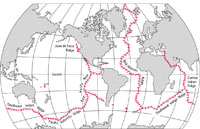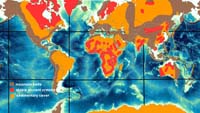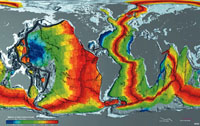3.20: Another Geologic Paradox- The Rocks of the Ocean Floors are Much Younger than the Rocks of the Continents
- Page ID
- 9844
Another Geologic Paradox: the rocks of the ocean floors are much younger than the rocks of the continents
In the late 1940's methods of radiometric-age dating were developed. After WW2, samples of ocean crust and sediments were collected from the sea floor throughout the world ocean basins and analyzed using both radiometric-age dating (decay of radioactive isotopes) and relative dating (using microfossils derived from seafloor sediment coring samples). Geologic data indicated a relatively young sea floor (ocean crust), where the oldest is about 200 million years old. However, data also indicated very old continents, where the oldest was more than 3 billion years old!
- Continental crust is made up of rocks measured into the billions of years, especially in the stable craton cores of continental shields (mostly in the central region of continental landmasses) (Figure 3.34).
- The oldest ocean crust is about 200 million years (Figure 3.35) The oldest ocean crust is found in locations near continental land masses (such as the east coast of North America) and near volcanic island arcs along the western side of the Pacific Basin.
As shown in Figures 3-33 to 3-36, the maps shows the bathymetry and geologic ages of the ocean basins, highlighting long undersea mountain ranges (mid-ocean ridges) that extend thousands of miles near the middle of the Atlantic and Indian Oceans, and part of the eastern Pacific Ocean basin. Although early oceanographic studies revealed mountains hidden beneath the oceans, a complete map of the ocean floor wasn't compiled in detail until starting in World War II as part of naval research for submarine warfare. Although some data regarding the age of continental rocks was partly known before the war, much detail of the geology of continental regions wasn't available until global energy and mineral resource mapping was conducted in the decades following the war.
What was discovered was that, in general, most of the oldest rocks found in the Earth's crust occur in the center of continental landmasses, such as in the Canadian Shield region of North America, Greenland, the central parts of Africa, South America, Australia, and Siberia, and the peninsula of India (Figure 3.34).Thee regions have rocks that range in age to typical over a billion years to the oldest know rocks of about 4.4 billion years (from Australia). These regions are called continental shields. Note that it is within these regions that most of the world's most economically significant gem and precious metal deposits are found!
Surrounding the continental shields on most of the continents are belts of mountain ranges and coastal plains that contain rocks younger that a billion years in age. The higher mountain ranges, including the Himalayan, Andes, Alps, and Rocky Mountains are considered to be actively forming and are dominated by rocks that have formed after the breakup of the supercontinent Pangaea (mostly after about 300 million years ago). There are some older mountain ranges, like the Appalachian Mountains in eastern North America, that appear more worn down, and the areas are relatively inactive geologically (having fewer earthquakes and little recent volcanic activity). By comparison, the landscapes within the shield regions are nearly completely worn down and are no longer geologically active. However, these shield regions display characteristics of having once been parts of mountain ranges that existed a billion or more years ago. In many areas parts of the shield regions, ancient mountain ranges have formed, eroded away, and reformed again and again, but today, in contrast, there is very little geologic activity (volcanoes or earthquakes).
Figure 3.35 is a map showing the age of rocks found in the crust beneath the ocean basins of the world. Again, beginning in earnest during World War II and culminating in the Cold War, geophysical mapping and sampling of materials from the sea floors around the globe showed that rocks on the ocean basins were very significantly younger that rocks found on the continents, with ages ranging in only about 200 million for the oldest rocks beneath ocean basins! In all cases, the age of seafloor grows progressively younger approaching the mid-ocean ridges. Using seismic data and deep-sea submersible exploration craft, the mid-ocean ridges were discovered to be belts of undersea volcanic areas. New ocean crust was (and is) forming along the mid-ocean ridges (Figure 3.36). In contrast, old ocean crust is sinking back into the mantle or being added onto some continental margins (discussed in Chapter 4).

Figure 3.36. Map showing the location of the world's mid-ocean ridges. These undersea mountain ranges are the longest on earth. Mid-ocean ridges (where new ocean crust is forming) is found beneath portions of all the world's ocean basins.




